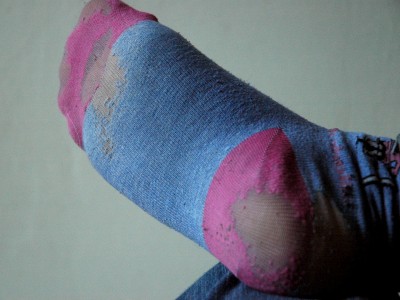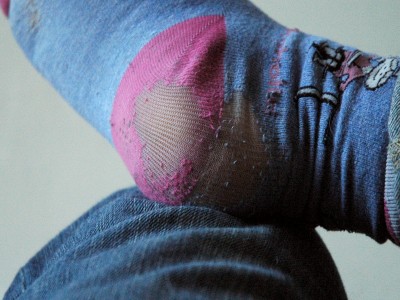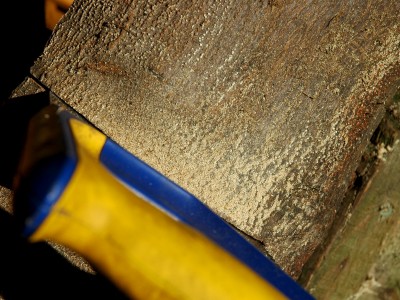Do you darn?
These are the socks I’m wearing today:
(Well, the “undersocks” I’m wearing today – I’ve got some big fluffy ones on top – I feel nude if I’m wearing less than two pairs of socks in winter :) )
I’m good at stitching up small holes in socks but when it comes to threadbare patches like these … well, there’s a reason why these threadbare bits are so big!
I’m always more inclined to fix thick socks than this thin sort as I don’t think my needle skillz could manage a very good job on these. But a whole load of my socks have gone this way recently (especially “novelty” ones like these, which I got as Christmas presents when I still got Christmas presents a decade ago) and I’m thinking I need to do something about it — because my sock drawer is rather depleted and I’ve used up all my old worn-out sock reuse/recycling ideas for the time being.
So do you darn? How easy is it to learn how to do it properly/neatly? Would you darn this type of sock or save your time for better quality ones?
Read MoreBook Review: Stitch Step by Step by Maggi Gordon and Ellie Vance
It was a moment of serendipity when I spotted this book, Stitch Step by Step by Maggi Gordon and Ellie Vance, on the “new additions” shelf at the library back in September – I didn’t know it but I was about to get poorly sick — not ill enough to just collapse in a heap but not well enough to, you know, move. I suddenly found myself with a lot of sewing playtime!
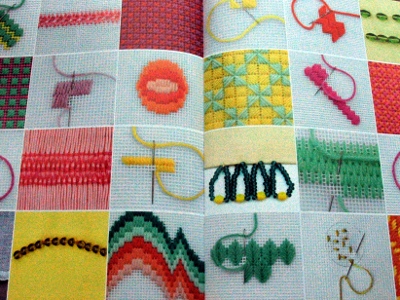
The design of the book grabbed me from the outset: the pretty blue/dotty cover; the clear, well laid out tutorial pages; and the stitch galleries, oh my, the stitch galleries.
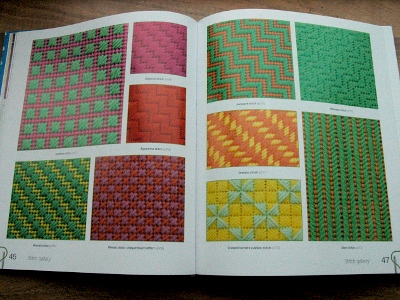
I think it’s worth noting that I’m quite new to embroidery. I’ve cross-stitched for a few years now but I’ve not spent a lot of time looking into the different stitches available when you break away from the cross (or fractions of it) and backstitches. The stitch galleries in this book really opened my eyes to the different possibilities – I could suddenly see the appeal of making samplers! As this is nearly all counted-thread work, it didn’t seem a million miles from my cross-stitching and it gave me the confident to jump straight into some stitching myself.
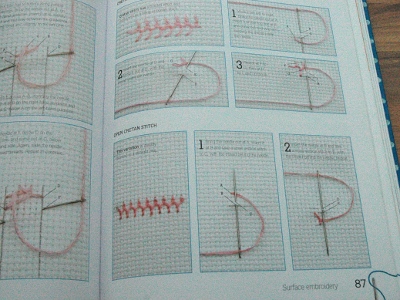
I’ll admit, I followed a handful of the tutorials because it was clear to see what to do from the stitch gallery pictures but those that I did follow were clear step-by-step guides as the title of the book suggests :) The pictures were crisp, with good fabric/thread contrast so it was easy to see what was going on. (The one I “chose” to take bad pictures of to illustrate this point is probably the least contrasting one but you can see the layout.)
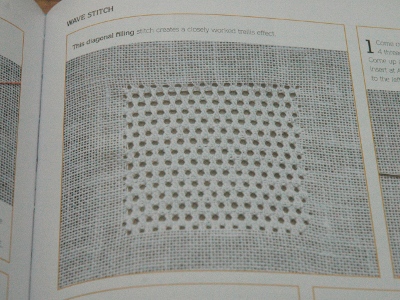
In addition to the colourful thread work, there were also sections on whitework – which was a new concept to me (the idea of using the stitches to open up holes in the fabric I mean, not just the white-on-white stitching), using beads & sequins and on designing as well as stitching Florentine/Bargello work. Purr. Me like!

As with all tutorial books, they covered the basics as well – how to use embroidery hoops, useful tools, finishing and whatnot – which again, was useful for a newbie like me.
Overall, I didn’t read this book cover-to-cover or feel like I wanted to try every different stitch/tutorial – but it’s not for that: it’s for providing inspiration and reference, and I think it does those things very well.
I did have two minor problems with it though – both design issues. Firstly, I had the hardback version from the library. Apparently there is a paperback version available too — I think the hardback would be better than that but better still would have been a ring-bound hardback, that could have sat open of its own accord on my knee while I was stitching.
The second problem I had was a minor – but very annoying – thing: each page number was decorated with a cute image of a needle and thread. I would see it out of the corner of my eye and try to brush it away. On every. single. page. Sometimes multiple times on each page. ARRRGGGH!! ;)
All in though, I’m very glad I came across it and next time I’m in a sewing mindset (I’m all about crochet at the moment), I think I might have to add it to my bookshelf at home.
Read MoreFive things
ONE. Two of the chickens are in moult – Ginger the Black Rock and Ms Mauve, an ISA Brown. There have been a lot of feathers about in the coop and run but neither have gone too bald (… yet?). Both have lost their tail feathers so look strangely round and last week both lost neck/head feathers, but Ginger’s have pretty much grown back now, so only Ms Mauve is left looking bit funny.
(I’m not keeping them/her in a separate run from the rest of the crew during the moult, just some of the others had just wandered outside of the run while I was taking photos. She followed shortly afterwards when she realised that there were leaves to scratch in out there, weeeee!)
TWO. Sticking to chicken related things, we’ve discovered that if chickens eat achocha, it taints their eggs like onions or (wild) garlic. I’ve been feeding the chicken some of the many, many achocha fruit we’ve had this season in an effort to get through them before the frost turns them all to mush. They weren’t sure about them at first but now om-nom-nom them up. We discovered the tainting issue – which isn’t unpleasant, per se, in savoury food but definitely there – on Monday, just after I’d taken them the remains of the entire 15ft tall wall of achocha to pick through. Monday’s eggs have been quarantined so they don’t accidentally get used for a dessert!
THREE. One of the reasons why I’ve not been writing much here is #NaNoWriMo – National Novel Writing Month. All my spare (and not so spare) time has been sucked up by that, so not only have I not been blogging much, I’ve not really been crafting or playing either. But on the plus side, because I’ve been so focus, I’ve written over 60,000 so far and I’ve not been idly browsing the web or eBay so I’ve saved money by avoiding temptation. Woo!
FOUR. Despite #NaNoWriMo getting in the way of my crafting, I have had a couple of evenings off from writing (when I was too exhausted/distracted to write the day we found Kia and after a busy day in the garden at the weekend) and I’m only about four rows off finishing the back of one of my crochet tops. If I hadn’t been writing, it would be long finished by now – and I’ve got an idea of how I can make another one which is just as nice but even quicker. Because I don’t already have enough WIPs…
FIVE. A little paranoid perhaps but I’m rather aware how quickly we’re getting through our wood pile. I cut a load of wood on Sunday but we’ve already nearly got through the ones for the “big” stove in the office. I think we might start using the central heating more until the winter properly kicks in, so we can see what it holds: I’m worried about racing through all our wood supplies now, then finding ourselves without heating for a fortnight during a super cold spell like we did last year (our boiler broke at just the wrong time). I much prefer our free heating from wood than our expensive gas, but I think I’d rather have a few weeks of expensive warmth than risk having no warmth at all!
What’s going on in your life this week?
Read MoreBy hand or by power: how do you cut your firewood?
I’ve just taking advantage of another lovely autumn morning to cut some more wood for use over winter.
I was enjoying the sweet victory of finishing another log when I accidentally grazed the blade of the saw against my finger. It’s nothing – the hint of a graze, it drew red but not drops of blood – but it did make me grateful for the eleventeenth time that we use handsaws to slice the logs into stove size pieces.
John’s dad bought us a circular saw as a present last year – I believe it was ex-display or similar, so too good to be missed in his eyes – but we’ve not used it. John’s dad uses it when he’s working here (to save bringing his own) and I think John himself has used it once — but after his own handsaw/cut-hand incident a few weeks ago, I suspect he’s unlikely to use it again.
We’re … not the most graceful people. It’s not that we’re inattentive, we’re just clumsy. Sure, it takes longer but it’s not too hard work with a decent coarse-wood saw – we like the exercise that handsawing gives us desk-dwellers and that the wood gets to warm us more than once. We also like our fingers – it’s how we make our money, tip-tap-typing away at our desks – and dislike risking them unnecessarily.
But rejecting the metal menace sometimes feels like a bit of a Luddite manoeuvre. It also feels hypocritical: for example, we’re happy for John’s dad to use his big petrol chainsaw to cut a big tree into splittable logs (the splitting is done by hand) rather than us going at it for half an hour with a two handed saw.
If you use wood as fuel, do you cut it by hand or do you use power tools?
Read MoreOn the hook – draught excluder & cowl/tank top
Inspired by Steel Kitten‘s “What’s in the knitting bag?” post, I thought I’d talk about what’s on my crochet hook. (I’m supposed to be having a week away from the computer this week doing crafty things — I’ve not been very successful at the “being away from a computer” thing so at least I should write about my crafty pursuits, right? ;) )
As I mentioned on here and Twitter last week, I’ve not been hooking for ages but now I’ve started again, I’m in it with a passion. Last week I started a made-up-as-I-go snake draught excluder – the tail on my first version was too short but made a natty hat for cheeky Lily-dog —

— so I frogged that and started again but naughty, naughty, I got distracted by wanting personal insulation instead.
A trip to the yarn shop later (Texere Yarns in Bradford), I’m now working on a version of the Ginny Cowl (Ravelry pattern link). I love the shape of the finished top and the pattern is deliciously simple – but I’ve had to change things a bit because I don’t know whether it was my too-round-headed hook’s fault, the fluffy yarn’s fault or my too-tight tension’s fault but doing the slip stitches in back loops was arrrrrggghh! Hate. I’m not 100% convinced my version will look as good as the proper Ginny Cowl and I wish I could have stuck with the original pattern, but my version stands a lot more chance of actually being completed (since it’s fun not frustrating to make) rather than thrown on the ground in a huff. Details to follow if it does work!
Are you crocheting/knitting anything at the moment?
Read MoreMy ten favourite simple living/growing/cooking/making books
(Inspired by book-aholic buying behaviour this month, I’ve decided to have a bit of a book-themed week both here and on my recycling site, Recycle This.)
Despite living on the internet & using it/blogs for most of my day-to-day info, I’ve got quite a few simple living related books and as you might expect, some are better than others. Some were chosen after careful research, others randomly picks from charity shops & the like – but as is often the case, there is little correlation between that and which are the better books!
Here, in no particular order, are some of my favourites:
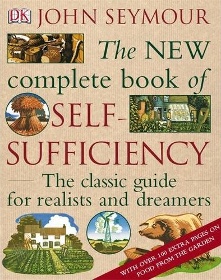
- The New Complete Book of Self-Sufficiency by John Seymour – this is a great overview book of so many different things. It’s admittedly more aspiration than practical for me at the moment – and because it covers so many different areas, it doesn’t feel like the most practical book anyway (it doesn’t have space to go into detailed how-tos/trouble-shooting on each different topic) but it’s still very useful. If I was fleeing to escape the zombie hordes*, this is probably the non-fiction book I’d grab.
Growing

- The Vegetable & Herb Expert by DG Hessayon – my first veg growing book and the one I keep going back to over & over again. Not hugely detailed on each type & some bizarre comments about only eating chillis if they’re part of “your heritage”, but very clear, with lots of pictures (very useful when troubleshooting pests/diseases) and packed with useful info.
- Grow Your Own Vegetables by Joy Larkcom – this book is almost the opposite of the Hessayon – lots of detail but not anywhere near as easy to dip into and few illustrations. I like them together but would struggle with the Larkcom on its own.
- The Edible Container Garden: Fresh Food from Tiny Spaces by Michael Guerra – I was a little disappointed when I got this as it includes a lot of whitespace, big pretty rather than purposeful pictures and a lot of general overview text — but the 30 pages on “what shall I grow?” made the book worth it – very useful reference information about varieties, pot depths etc. I would recommend it to anyone who grows more than just the basic herbs in containers – but try to find a secondhand one so you don’t resent paying for the padding.



